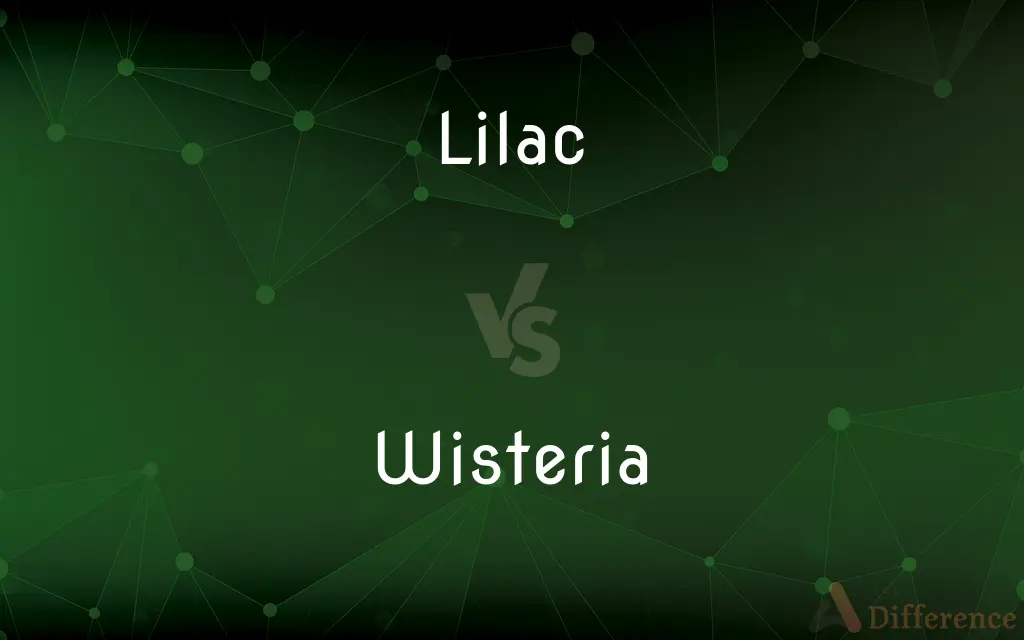Lilac vs. Wisteria — What's the Difference?
Edited by Tayyaba Rehman — By Fiza Rafique — Updated on November 3, 2023
Lilac is a bush with fragrant purple flowers, while wisteria is a climbing vine with cascading blue to violet flowers.

Difference Between Lilac and Wisteria
Table of Contents
ADVERTISEMENT
Key Differences
Lilacs are shrubs known for their sweet-smelling, typically purple flowers, which bloom in spring. Wisteria, on the other hand, is a genus of climbing vines known for their enchanting cascades of blue to violet flowers. While both plants are celebrated for their beauty and aromatic flowers, lilacs are more commonly used as standalone shrubs in gardens, whereas wisteria is often found draping over arbors and trellises.
The flowers of lilac bushes grow in dense clusters and their blooming period is brief, heralding the arrival of spring. Wisteria vines produce elongated, pendulous clusters of flowers that can create a stunning visual display when in full bloom. Lilacs are commonly associated with the Easter holiday and symbolize renewal, whereas wisteria often symbolizes long life and immortality in various cultures due to its longevity and vigorous growth.
In terms of care, lilacs generally require less maintenance and can be more resilient to colder temperatures. Wisteria, with its aggressive growth, may need regular pruning to maintain shape and prevent it from overwhelming other plants or structures. Lilacs prefer well-drained, humus-rich soil, while wisteria can adapt to a wider range of soil types but must have good drainage to prevent root rot.
When it comes to use in landscaping, lilacs are ideal for creating hedges or as accent plants. Wisteria vines are versatile and can be trained to grow in various forms, including tree-like shapes. The ability of a lilac to withstand pruning makes it a favorite among gardeners who wish to control the shape and size of their plants, whereas wisteria is often chosen for its dramatic and romantic draping quality.
Both lilacs and wisterias are deciduous and lose their leaves in winter. Lilac leaves are heart-shaped and arranged opposite each other, turning a deep green as they mature. Wisteria leaves are pinnate, with a feather-like structure, and provide a light, dappled shade when used to cover pergolas or arbors. While lilacs are primarily known for their flowers, wisteria also has attractive seed pods that persist into winter, adding interest even after the plant has lost its leaves
ADVERTISEMENT
Comparison Chart
Plant Type
Bush/Shrub
Climbing Vine
Flower Shape
Dense clusters
Long, pendulous clusters
Bloom Duration
Short, typically a few weeks
Longer, often several weeks
Growth Habit
Upright and contained
Aggressive, sprawling
Symbolism
Renewal, Easter
Longevity, immortality
Maintenance
Less, hardier in cold
More, needs pruning
Soil Preference
Well-drained, humus-rich
Adaptable, but requires good drainage
Compare with Definitions
Lilac
A flowering shrub with aromatic purple blossoms.
The lilacs added a splash of color to the garden.
Wisteria
A vine known for its cascading blue or purple flowers.
The wisteria covered the pergola beautifully.
Lilac
A light violet color named after the flower.
She wore a dress the color of lilac.
Wisteria
A hardy climber that can live for many years.
The ancient wisteria at the manor was over a century old.
Lilac
Symbolic of first love in the language of flowers.
He gave her a bouquet of lilacs to express his burgeoning affection.
Wisteria
Can be trained to grow in tree form or along structures.
The gardener expertly trained the wisteria along the old stone wall.
Lilac
An ornamental plant commonly associated with the early spring.
The blooming lilacs signaled the end of winter.
Wisteria
Often used in traditional Japanese and Chinese gardens.
The wisteria in the temple garden was in full bloom.
Lilac
A Eurasian shrub or small tree of the olive family, which has fragrant violet, pink, or white blossom and is a popular garden ornamental.
Wisteria
Wisteria is a genus of flowering plants in the legume family, Fabaceae (Leguminosae), that includes ten species of woody twining vines that are native to China, Korea, Japan, Southern Canada, and the Eastern United States. Some species are popular ornamental plants.
Lilac
Any of various shrubs of the genus Syringa, especially S. vulgaris, which has been widely cultivated for its clusters of fragrant flowers that are usually purplish or white but may be pink, blue, or creamy yellow depending on the cultivar.
Wisteria
Any of several climbing woody vines of the genus Wisteria in the pea family, having pinnately compound leaves and drooping racemes of showy purplish or white flowers.
Lilac
A pale to light or moderate purple.
Wisteria
Any of several woody climbing vines, of the genus Wisteria, native to the East Asian countries of China, Korea, and Japan and the eastern United States.
Lilac
A large shrub of the genus Syringa, especially Syringa vulgaris, bearing white, pale-pink, or purple flowers.
Wisteria
Same as Wistaria.
Lilac
A flower of the lilac shrub.
Wisteria
Any flowering vine of the genus Wisteria
Lilac
(color) A pale purple color, the color of some lilac flowers.
Wisteria
A plant that requires full sun and well-drained soil to thrive.
They planted the wisteria on the south-facing wall to ensure it got enough sunlight.
Lilac
Having a pale purple colour.
Lilac
A shrub of the genus Syringa. There are six species, natives of Europe and Asia. Syringa vulgaris, the common lilac, and Syringa Persica, the Persian lilac, are frequently cultivated for the fragrance and beauty of their purplish or white flowers. In the British colonies various other shrubs have this name.
Lilac
A light purplish color like that of the flower of the purplish lilac.
Lilac
Any of various plants of the genus Syringa having large panicles of usually fragrant flowers
Lilac
Of a pale purple color
Lilac
A fragrance reminiscent of the lilac shrub's flowers.
The room was filled with the scent of lilac.
Common Curiosities
Do lilacs and wisterias attract pollinators?
Yes, both attract bees and butterflies with their flowers.
Are lilac and wisteria blooms fragrant?
Both have fragrant blooms, with lilac being notably sweet-smelling.
Are lilacs and wisterias evergreens?
No, both lilac and wisteria are deciduous and lose their leaves in winter.
How fast do lilacs and wisterias grow?
Lilacs grow at a moderate rate, while wisterias are known for rapid growth.
Are there different colors of lilac and wisteria flowers?
Lilacs come in purple, white, and pink, while wisterias are typically blue, purple, or white.
Is it easy to propagate lilac and wisteria?
Both can be propagated, but wisteria is often grafted for faster flowering.
Can both lilac and wisteria be grown in pots?
Lilacs can be grown in pots, but wisteria typically requires more space to thrive.
Are lilac and wisteria resistant to pests and diseases?
Both can be fairly resistant but may encounter specific pests or diseases such as powdery mildew.
How long does it take for lilac and wisteria to bloom after planting?
Lilacs may bloom within a few years, while wisteria can take several years to flower.
Can both lilacs and wisterias withstand frost?
Lilacs are more cold-hardy, while wisteria can be damaged by late frosts.
Do both lilacs and wisterias need regular pruning?
Wisterias require regular pruning; lilacs should be pruned lightly after blooming.
What's the best time to plant lilacs and wisterias?
Both should be planted in either spring or fall for best results.
Can lilacs and wisterias be used as cut flowers?
Lilacs are commonly used as cut flowers; wisterias are less common due to their drooping clusters.
Are lilac and wisteria suitable for all garden sizes?
Lilacs can fit in smaller gardens, while wisterias need more space and are better for larger areas.
Do lilacs and wisterias require a lot of water?
Both plants prefer well-drained soil and should be watered deeply but infrequently.
Share Your Discovery

Previous Comparison
Flee vs. Fly
Next Comparison
Bate vs. BaitAuthor Spotlight
Written by
Fiza RafiqueFiza Rafique is a skilled content writer at AskDifference.com, where she meticulously refines and enhances written pieces. Drawing from her vast editorial expertise, Fiza ensures clarity, accuracy, and precision in every article. Passionate about language, she continually seeks to elevate the quality of content for readers worldwide.
Edited by
Tayyaba RehmanTayyaba Rehman is a distinguished writer, currently serving as a primary contributor to askdifference.com. As a researcher in semantics and etymology, Tayyaba's passion for the complexity of languages and their distinctions has found a perfect home on the platform. Tayyaba delves into the intricacies of language, distinguishing between commonly confused words and phrases, thereby providing clarity for readers worldwide.
















































